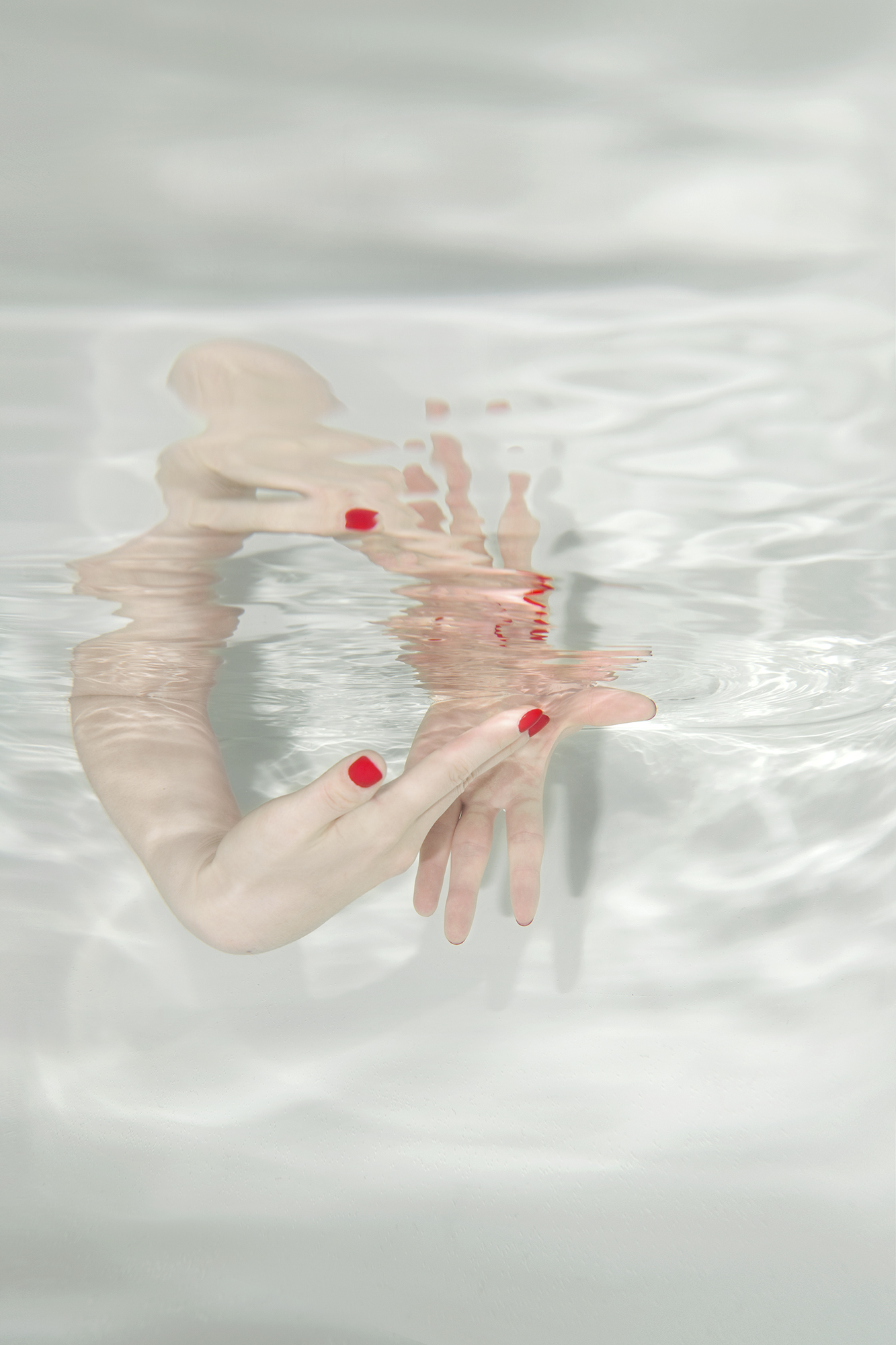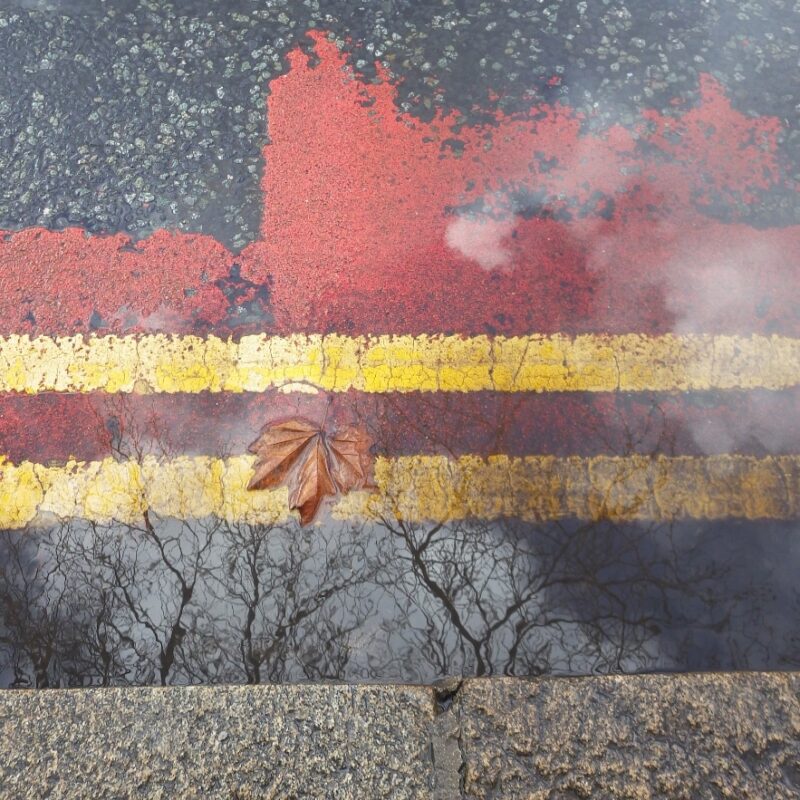Ciao Julija, parlaci di te e di come hai cominciato con la fotografia.
Sono nata a Vilnius, in Lituania. In origine ero un economista. Non ho iniziato a lavorare nel settore foto/video subito dopo la mia laurea, nel mentre ho cambiato percorso dalla finanza alla recitazione. È stato solo dopo essermi trasferita a Berlino nel 2010 che ho iniziato a sentirmi coinvolta nel panorama artistico e ho iniziato la mia carriera professionale in campo creativo.
Come nasce il progetto “Water to air”?
Questo progetto si è sviluppato gradualmente. In un primo momento, ho iniziato a scattare foto dei miei amici di notte sui laghi. I risultati erano commoventi e misteriosi. Quell’immagine, catturata di notte con una torcia nei bacini bui, mi sembrava una sorta di porta d’accesso ad un mondo misterioso, così coinvolgente e trascendente. Ho deciso di approfondire il tema dell’acqua e ho iniziato a cercare rappresentazioni più uniche e interessanti. Mi ci è voluto un po’ di tempo per studiare la fisica della luce e la sua fenomenologia, come l’effetto rifrazione. Ho anche passato ore a guardare documentari sul mondo sottomarino, ispirati dalle forme aliene delle specie che ci vivono. E dopo che tutte queste cose e soggetti si sono radunati, ho capito di essere pronta a lavorare sulla serie “Water to air”.
Queste immagini sono girate mettendo un fascio di luce e una fotocamera sotto la sua superficie. Immergendoci, non solo abbracciamo uno spazio estraneo alla nostra vita e alla nostra sopravvivenza, ma anche uno spazio che, per le sue proprietà fisiche, cambia il modo in cui lo percepiamo. Il fenomeno, che in fisica si chiama “Riflessione Interna Totale”, fa apparire la superficie acqua-aria come uno specchio perfettamente argentato. Di conseguenza, guardiamo agli esseri stranamente incarnati, che assomigliano a creature inquietanti che galleggiano in una solitudine interna di spazio apparentemente infinito.
Quali sono le tue fonti di ispirazione?
Di solito traggo ispirazione dai libri. Mi piace leggere di scienza e filosofia. Ma questa non è la mia unica fonte di ispirazione – sono mossa facilmente dal lavoro di altri artisti, così come da situazioni di vita quotidiana o incontri che cambiano o deviano le mie prospettive. Penso che per tutti sia una cosa individuale, ma per qualche ragione sono convinta che questo momento, che ti muove in un posto diverso (mentalmente o emotivamente), è abbastanza essenziale per l’ispirazione.
Come hai trovato I tuoi soggetti? Qual è la prima cosa che fai prima di intraprendere un progetto?
Penso che siano le storie a trovare me. L’unica cosa che faccio è cercare di restare aperta e ricettiva. E se sento che vengo attivata da qualcosa in modo creativo, che mi parla e che possono trasformare, le cose accadono senza nemmeno forzarle – faccio un sacco di test , ricercando e leggendo. Di solito è un processo piuttosto complicato prima che il progetto finale nasca, e ci sono casi in cui servono anni prima che sia finito. Mi ci è voluto un po’ per imparare a lasciar andare alcune idee ,a volte inizio a lavorare su qualcosa, ma nel processo sento che non so ancora come completarla, semplicemente la lascio in sospeso. Su alcuni progetti non ritorno mai, ma ce ne sono altri che ho ripreso dopo qualche anno. Mi piace, mi piace davvero il momento in cui ritorno ad alcuni dei miei vecchi progetti, perché rassicura il mio percorso creativo.
Hello Julija, can you talk about you and how did you start with photography?
I was born in Vilnius, Lithuania. Originally I was trained as an economist. I didn’t start working in photography and video right after my graduation, in between I changed careers from finances to acting. It was only after I settled in Berlin in 2010 that I started to be involved in the art scene and began my professional career in the creative field.
How the project “Water to air” is born?
This project developed gradually. At first, I started taking pictures of my friends at night on the lakes. The results were moving and mysterious. That imagery, caught at night with a flashlight in the dark basins, seemed to me to be some kind of gateway to an uncanny world, so immersive and transcendent. I decided to dig deeper into the subject of water and began searching for more unique and interesting representations. It took me some time to study the physics of light and its phenomenology, such as the refraction effect. I also spent hours watching documentaries about the underwater world, inspired by the alien forms of the species that live there. And after all these things and subjects had settled together, I knew I was ready to work on the “Water to air” series.
These images are shot by placing a beam of light and a camera underneath its surface. By entering underwater, we embrace not only a space, which is alien to our life and foreign to our survival, but also a space, which, due to its physical properties, changes the way we perceive it. The phenomenon, which in physics is called “Total Internal Reflection”, makes the water-to-air surface look like a perfectly silvered mirror. As a result, we look at strangely embodied beings, which resemble uncanny creatures floating in an internal solitude of seemingly endless space.
Which are your inspirations?
I usually get my inspiration from books. I enjoy reading science and philosophy. But that’s not my only source of inspiration – I’m easily moved by the work of other artists, as well as by everyday life situations or encounters that change or shift my perspectives. I think it’s an individual thing for everyone, but for some reason I’m convinced that this moment, which moves you to a different place (mentally or emotionally), is quite essential for the inspiration.
How did you find your stories? What is the first thing that you make before start a project?
I think stories always find me by themselves. The only thing I do is try to stay open and receptive. And if I feel, that I am triggered by something creatively, that it speaks to me and I can transform it, things happen without even forcing them – I do a lot of testing , researching and reading. It’s usually quite a complicated process before the final project is born, and there are times when it takes years before it’s finished. It took me sometime to learn to let go some ideas – sometimes I start working on something, but in the process I feel that I don’t yet know how to complete them, I simply leave it open. To some of them I never return, but there are some projects, which I restarted again after some years. I like it, I truly like the moment when I return to some of my old projects, because it reassures my own creative path.
IG: julijagoyd
Website : julijagoyd.com
















